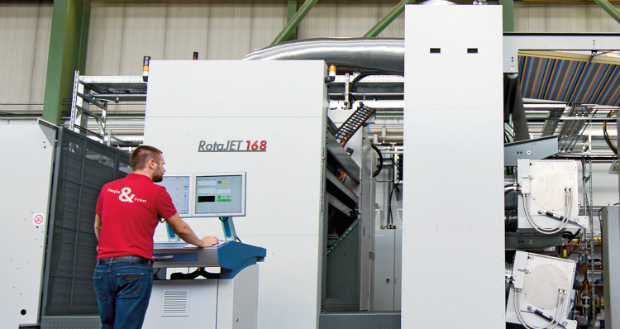KBA has published its financial statements for 2014, saying that group sales at €1.1bn come at the top end of its 2013 forecast.
The company can see initial positive impacts from its group realignment which began last year. Compared to the previous year, when restructuring expenses of over €155m strained its operating result, in 2014, both its sheetfed offset segment and the web and special press division posted an operating profit. It enjoyed a rise in operating profit of €14.1m, higher than planned a year ago. The pre-tax profit came to €5.5m and a group net profit of €0.3m also exceeded the forecast.
Claus Bolza-Schünemann, president and chief executive of KBA, says, “We made rapid progress in the first twelve months of the most extensive realignment project in our company’s recent history and were pleased to see its positive effects earlier than anticipated.”
However, the increase in new sheetfed orders could not fully compensate for decline in web and special presses. KBA says that order intake in 2014 faced negative external impacts resulting from numerous global conflicts, economic weakness in parts of Europe and in key emerging countries, as well as slower growth in China. The company’s strong position in folding carton, and metal decorating, helped to lift its order intake for sheetfed slightly from €608m to €610.1m, bucking the industry trend. KBA adds that sluggish business trends in newspaper and publication printing continued. Combined with a slide in demand for security presses, this led to a fall in order intake of 14.2 per cent compared to the previous year. At €956.9m, the total volume of new press orders slipped 5.5 per cent on the prior-year figure.
The KBA Fit@All restructuring programme aims to end the group’s dependence on shrinking markets, such as newspaper and publication printing. KBA management expects these measures to lead to a more stable level of capacity utilisation and appropriate earnings, also in these business units. At the end of the year group order backlog came to €417.3m, compared to €560.5m in 2013.
While sales of sheetfed offset presses were up 3.3 per cent, the web and special press segment sank by 3.5 per cent. However, KBA-Kammann and KBA-Flexotecnica, which deliver special presses for the packaging printing market, helped compensate for that and sales of coding systems from KBA-Metronic rose slightly. The KBA digital printing field also contributed to sales with the delivery of the first KBA RotaJET 168 to a German decorative printer.
China remains KBA’s largest market despite a dip in growth. With a slide in growth in China and economic weakness in Thailand, sales attributable to Asia and the Pacific eased down from €301m in 2013 to €263.4m. Sales in Germany sank by 8.3 per cent but deliveries to other parts of Europe increased by 17.8 per cent. Sales generated in North America stood at €117.6m or 10.7 per cent of the total, compared to 12.8 per cent last year.
The sheetfed offset segment generated an operating profit of €11.5m in 2014 and a €2.6m operating profit for web and special presses. KBA believes its web offset business will have brighter future prospects albeit on a significantly smaller scale through its grouping with growing inkjet digital activities in the new KBA-digital and web solutions business unit.
At €43.2m, cash flows from operating activities exceeded the previous year’s figure of €34.1m significantly in spite of a fall in customer prepayments and considerable cash outflows for severance payments. After deducting funds for investments, the free cash flow soared to €28.7m compared to €3.2m the year before. KBA says that it achieved this, and the improvement in earnings, through a reduction in inventories and receivables.
At the end of 2014, KBA had a staff roll of 5,731 staff, 678 fewer than at the end of 2013. Excluding apprentices, trainees and those who have already left the company the number of employees in the group sank to 5,114. Payroll will fall again to about 4,500 by the end of 2016 from restructuring.
As part of the realignment, the KBA management board is preparing the shift from a functional to a divisional organisation structure to strengthen the group’s corporate governance system. Goals include increased transparency, clear management responsibility and targets in all business units, no tolerance for loss-makers, no cross-subsidies as well as capital expenditure according to strategic objectives and projected returns. The new structure will be submitted to the AGM in May for implementation from January 1.
KBA sees no overall growth for the global press market in 2015. However, the group’s management board perceive further opportunities for growth predominantly in digital and packaging printing. In digital printing, KBA aims to focus more on applications with challenging materials and large substrate widths. It has developed flexible digital press platforms with the RotaJET L and RotaJET VL and it expects to see the first results from its partnership with HP for the development of an inkjet press for the digital corrugated printing sector.
The KBA management does not anticipate any significant special expenses in the group financial statements for 2015, adding that cost-saving effects from already implemented measures will have an increasingly positive impact on earnings and liquidity available. KBA management will target over €1bn in group sales for 2015 and anticipates an improvement in earnings to an EBT margin of up to two per cent of sales.
KBA management believes more detailed forecasts for the new fiscal year and beyond would entail too many unknown factors at present to be of any merit.


